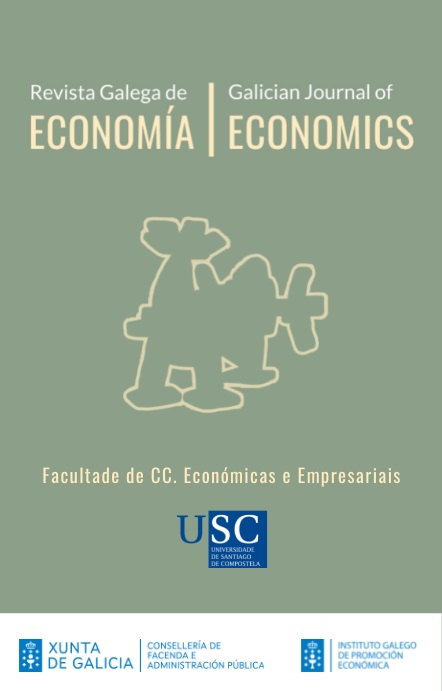Xeración de residuos derivados do turismo receptor en Galicia
Contido principal do artigo
Resumo
Palavras-chave:
Detalles do artigo
Referências
ALCÁNTARA, V. (2007): “Anàlisi input-output i medi ambient: una aplicació a la determinació de sectors clau en les emissions d’SOx a Catalunya”, Nota d’Economia. Revista d’Economia Catalana i de Sector Públic, 87 (1r. quad.), pp. 199-213.
ALCÁNTARA, V.; PADILLA, E. (2009): “Input-Output Subsystems and Pollution: An Application to the Service Sector and CO2 Emissions in Spain”, Ecological Economics, 68 (3), pp. 905- -914.
ARCHER, B.H. (1982): “The Value of Multipliers and their Policy Implications”, Tourism Management, 3 (4), pp. 236-241.
BAUMOL, W.J.; BLINDER, A.S. (1988): Economics, Principles and Policy: Microeconomics. 4ª ed. San Diego, CA: Harcourt Brace Jovanovich.
BLAKE, A.; ARBACHE, J.; SINCLAIR, M.T.; TELES, V. (2007): “Tourism and Poverty Relief”, Annals of Tourism Research, 35 (1), pp. 107-126.
COMISIÓN EUROPEA (2001): Decisión 573/2001/CE, de 23 de julio de 2001, que modifica el Catálogo Europeo de Residuos (CER). Diario Oficial de las Comunidades Europeas, nº L 203, de 28/07/01. Bruselas: Comisión Europea.
DORFMAN, R. (1954): “The Nature and Significance of Input-Output”, Review of Economics and Statistics, XXXVI (2), pp. 121-133.
ESPAÑA. MINISTERIO DE MEDIO AMBIENTE Y MEDIO RURAL Y MARINO (2009): Resolución de 20 de enero de 2009, de la Secretaría de Estado de Cambio Climático, por la que se publica el Acuerdo del Consejo de Ministros por el que se aprueba el Plan Nacional Integrado de Residuos para el período 2008-2015. Boletín Oficial del Estado, nº 49, de 26/02/09.
FLETCHER, J.E. (1989): “Input-Output Analysis and Tourism Impact Studies”, Annals of Tourism Research, 16 (4), pp. 514-529.
FLETCHER, J.E. (1994): “Input-Output Analysis”, en S. Witt e L. Moutinho [ed.]: Tourism Management and Marketing Handbook. New York, NY: Prentice Hall.
FRETCHTLING, D. (1994): “Assessing the Economic Impacts of Travel and Tourism”, en J.R. Brent Ritchie e Ch.R. Goeldner [ed.]: Travel, Tourism, and Hospitality Research: A Handbook for Managers and Researchers, pp. 359-402. 2ª ed. New York, NY: Wiley.
GAGO, A.; LABANDEIRA, X. (2001): “Turismo y fiscalidad ambiental”, Papeles de Economía Española, 87, pp. 179-186.
HAWDON, D.; PEARSON, P. (1995): “Input-Output Simulations of Energy, Environment, Economy Interactions in the UK”, Energy Economics, 17 (1), pp. 73-86.
HENDRICKSON, C.; HORVATH, A.; JOSHI, S.; LAVE, L. (1998): “Economic Input-Output Models for Environmental Life-Cycle Assessment”, Policy Analysis, 32 (7), pp. 184-191.
INSTITUTO GALEGO DE ESTATÍSTICA (1998): Marco Input-Output de Galicia 1998. Santiago de Compostela: IGE. (30 de outubro de 2011). <http://www.ige.ue/>.
INSTITUTO GALEGO DE ESTATÍSTICA (1998): Marco Input-Output de Galicia 2005. Santiago de Compostela: IGE. (30 de outubro de 2011). <http://www.ige.ue/>.
INSTITUTO NACIONAL DE ESTADÍSTICA (2002): La Cuenta Satélite del Turismo de España. Metodología y primeras estimaciones 1996-1999. Madrid: INE.
INSTITUTO NACIONAL DE ESTADÍSTICA (2009): Cuenta de los residuos en España 2006. Madrid: INE.
INSTITUTO NACIONAL DE ESTADÍSTICA (2010): Cuenta Satélite del Turismo de España. Serie 2000-2009. (Nota de prensa 638). Madrid: INE.
INSTITUTO NACIONAL DE ESTADÍSTICA (2011): Encuesta sobre la Generación de Residuos en el Sector Industrial. Madrid: INE. (30 de outubro de 2011). <http://www.ine.es/>.
INSTITUTO NACIONAL DE ESTADÍSTICA (2011): Encuesta sobre la Generación de Residuos en el Sector Servicios. Madrid: INE. (30 de outubro de 2011). <http://www.ine.es/>.
INSTITUTO NACIONAL DE ESTADÍSTICA (2011): Encuesta sobre la Generación de Residuos en el Sector de la Agricultura y la Pesca. Madrid: INE. (30 de outubro de 2011). <http://www.ine.es/>.
LEONTIEF, W. (1936): Quantitative Input-Output Economics Relations in the Economic System of the United States. Cambridge, MA: Harvard University Press.
LEONTIEF, W. (1941): The Structure of American Economy, 1919-1929. An Empirical Application of Equilibrium Analysis. Cambridge, MA: Harvard University Press.
LEONTIEF, W. (1970): “Environmental Repercussions and the Economic Structure: An Input-Output Approach”, The Review of Economics and Statistics, 52 (3), pp. 262-271.
MILLER, R.E.; BLAIR, P. (1985): Input-Output Analysis: Foundations and Extensions. Upper Saddle River, NJ: Prentice-Hall.
UNSD; EUROSTAT; OECD; WTO (2008): 2008 Tourism Satellite Account: Recommended Methodological Framework (TSA: RMF 2008). (Statistical Commission: Report on the Thirty-Ninth Session, 26-29 February 2008. Tourism Statistics). (Jointly presented by the United Nations Statistics Division (UNSD), the Statistical Office of the European Communities (EUROSTAT), the Organisation for Economic Co-operation and Development (OECD) and the World Tourism Organization (UNWTO). (30 de outubro de 2011). <http://unstats.un.org/unsd/statcom/doc08/>.
Artigos mais lidos pelo mesmo (s) autor (es)
- Melchor Fernández Fernández, Diana Fernández Méndez, Alberto Meijide Vecino, A aplicación da Lei de dependencia en Galicia: efectos sobre la generación de empleo , Revista Galega de Economía: v. 22 n. 2 (2013)
- Melchor Fernández Fernández, Dolores Riveiro, A exclusión territorial como unha forma de manifestación dos procesos de exclusión social , Sémata: Ciencias Sociais e Humanidades: n. 30 (2018): Bioeconomics and the Memory of Territories: Transdisciplinarity for a Responsable Future
- Melchor Fernández Fernández, María-Celia López-Penabad, Ana Iglesias Casal, Desafíos socioeconómicos del cambio demográfico , Revista Galega de Economía: v. 29 n. 2 (2020): Special Issue. Socio-economic challenges of demographic change






